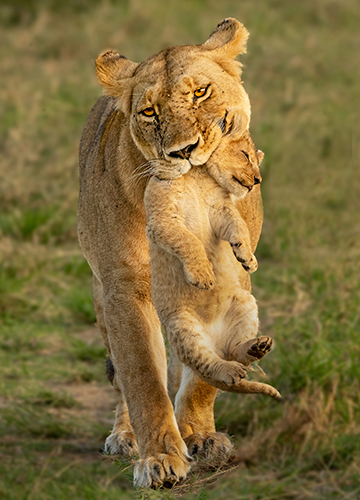One day, wildlife photographer Dileep Anthikad was photographing a pair of black-crowned night herons at the Abu Nakhlah wetland in Qatar. Unknown to him, the same pair of birds were in the gunsights of a sport hunter. He took down the birds, leaving Dileep heartbroken.
The incident in 2009 set him thinking. Was empathy enough for the wild? Or, as a nature lover, was it on people like him to do more? These questions prompted Dileep to quit his job in the oil and gas industry to take up conservation. In 2014, he played a crucial role in setting Qatar’s first private nature reserve, Irkaya Farm, 50 kms west of Doha. In 2017, he helped develop the 1.2 lakh hectare Al Reem Biosphere Reserve, 65 km northwest of Doha. It is Qatar’s only reserve to be recognised by the UNESCO.
Dileep’s love for wildlife prompted him to shift base to the Kenyan reserve of Masai Mara where he, along with conservationist and wildlife photographer Remya Anup Warrier, set up a river camp, Osero Sopia.
For the past 19 months, the simple-yet-cosy tents of Osero Sopia, in the middle of the 1,510 sq-km African savannah, are home to the two naturalists. They host guests, including hundreds of wildlife photographers, while playing an active role in conserving the robust wildlife.
Dileep’s tryst with Masai Mara began in 2009. A Birdguides/BBC award-winning photographer (2010), Dileep had travelled all over Africa, but Masai Mara stayed with him. It was getting in touch with Remya that resulted in the idea of a river camp. She too came with rich experience in conservation. Based in Singapore, she had travelled to reserves across Africa, including to Mashatu game reserve of Botswana, where she did her wildlife field guide course. The idea of a river camp in Masai Mara was a dream for her, too.
The work began in earnest in October 2020. Leasing land along the Talek river was the first step. It was a mean task, considering that the site came with challenges one would face in a remote part of Africa. Covid was another blow but with help from friends and the Masai community, Osero Sopia river camp was up and running by mid-2021.
The tents of Osero Sopia inspired by the magical sunset in Masai Mara and the ancient pyramid design of Africa are a reflection of Dileep’s vast field experience and Remya’s insight into nature’s art.
Photographers arrive here through the year and spend weeks watching wild animals from dawn to dusk. Dileep’s experience in grooming photographers and his field knowledge make him a veteran mentor, but he is not one to take Mara for granted. The cardinal rule: respect the space in everything, from preparing a territory for a photographer to lighting a fire at night. “It is sensitive, and we want it to be ethicWal. It is crucial to keep a safe distance from the animal. For instance, when a photographer encounters a predator going for kill, it is important that he stays a spectator and not spook predator or prey, despite the obvious excitement,” said Dileep. “We use our knowledge of animal behaviour to help photographers. If you want to catch a leopard in action, you should know its behaviour, its solitary nature and how it may choose to act in a given circumstance. A leopard perched on a tree with a kill is unlikely to come down anytime soon. Even if it comes down, we need to predict how it will behave, including which direction it may turn to.”
There are other technicalities, like the location of the sightings, where to position the vehicle, choosing the angle and background, and the effect of natural light. “This is especially important if the photographer wants to do something beyond a portrait. We believe a shot is best when it carries the imprints of the Mara habitat, be it the terrain or its famous sunrise, sunset and fog,” added Dileep.
Every session is a learning curve for the duo, too. They have founded an NGO for the conservation of local flora and fauna. “We learn about the nocturnal behaviour of predators, too,” Remya said. “We recently could observe the maternal instinct of a leopard. The big cat took great care of her cub for almost a year, before separating. This is rare since most leopards leave their cubs after six months. We often spotted her sharing her kill with her cub, but after the separation happened, the cub was just another competitor for food. We were amazed to watch mother and son fight over a kill.”
Life in Osero Sopia is a lesson on how man can co-exist with wildlife. The duo mentions multiple encounters with wildlife inside their camp, including with elephants, hippos, leopards, and even lions. “Once we encountered a beautiful male bushbuck moving towards our tent. We followed it, but then the buck started running towards us, making alarm calls, indicating the presence of a predator. It was then we spotted the lion with a Zebra kill nearby,” Remya said.
Life on the savannah can be challenging at times. They have dug wells for clean water and use solar power. Meat, vegetables and other essentials come from Narok town, or Nairobi. “We are probably the only Indian owners in Mara, serving the guests and nature alike,” said Dileep.
“We adopted one Masai village in Olelemuttia to ensure they had food and other resources during the Covid period. A scholarship programme for children was also launched,” said Remya.
Despite the hardships, their commitment to the cause keeps them going. “The wildlife heritage of Masai Mara belongs to all humanity with the great Masai tribe being its custodian. It is our responsibility to help them protect the abundant, yet vulnerable flora and fauna of this ecosystem,” said Dileep.



